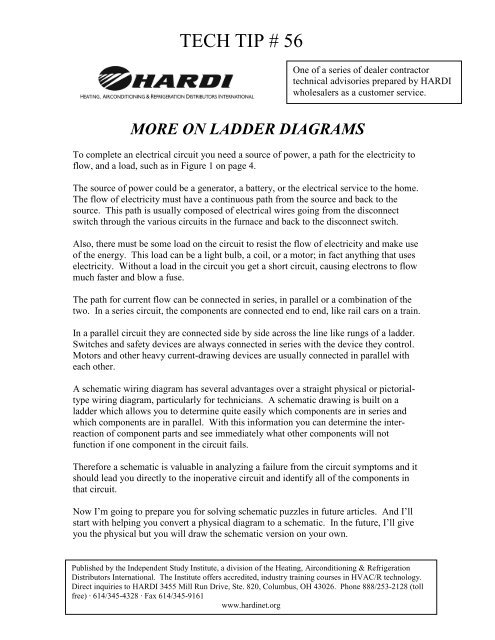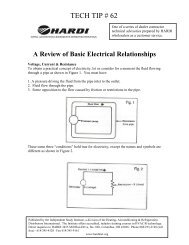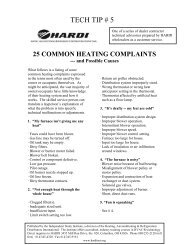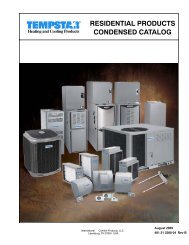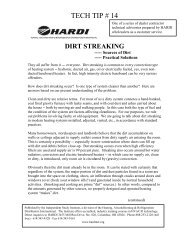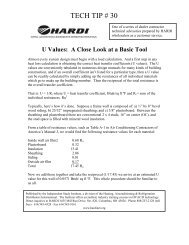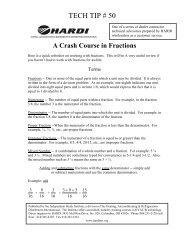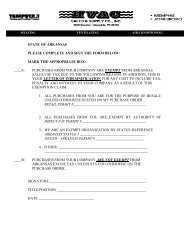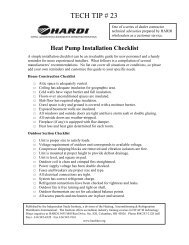on ladder diagrams - HVAC Sales & Supply Co., Inc.
on ladder diagrams - HVAC Sales & Supply Co., Inc.
on ladder diagrams - HVAC Sales & Supply Co., Inc.
You also want an ePaper? Increase the reach of your titles
YUMPU automatically turns print PDFs into web optimized ePapers that Google loves.
TECH TIP # 56<br />
One of a series of dealer c<strong>on</strong>tractor<br />
technical advisories prepared by HARDI<br />
wholesalers as a customer service.<br />
MORE ON LADDER DIAGRAMS<br />
To complete an electrical circuit you need a source of power, a path for the electricity to<br />
flow, and a load, such as in Figure 1 <strong>on</strong> page 4.<br />
The source of power could be a generator, a battery, or the electrical service to the home.<br />
The flow of electricity must have a c<strong>on</strong>tinuous path from the source and back to the<br />
source. This path is usually composed of electrical wires going from the disc<strong>on</strong>nect<br />
switch through the various circuits in the furnace and back to the disc<strong>on</strong>nect switch.<br />
Also, there must be some load <strong>on</strong> the circuit to resist the flow of electricity and make use<br />
of the energy. This load can be a light bulb, a coil, or a motor; in fact anything that uses<br />
electricity. Without a load in the circuit you get a short circuit, causing electr<strong>on</strong>s to flow<br />
much faster and blow a fuse.<br />
The path for current flow can be c<strong>on</strong>nected in series, in parallel or a combinati<strong>on</strong> of the<br />
two. In a series circuit, the comp<strong>on</strong>ents are c<strong>on</strong>nected end to end, like rail cars <strong>on</strong> a train.<br />
In a parallel circuit they are c<strong>on</strong>nected side by side across the line like rungs of a <strong>ladder</strong>.<br />
Switches and safety devices are always c<strong>on</strong>nected in series with the device they c<strong>on</strong>trol.<br />
Motors and other heavy current-drawing devices are usually c<strong>on</strong>nected in parallel with<br />
each other.<br />
A schematic wiring diagram has several advantages over a straight physical or pictorialtype<br />
wiring diagram, particularly for technicians. A schematic drawing is built <strong>on</strong> a<br />
<strong>ladder</strong> which allows you to determine quite easily which comp<strong>on</strong>ents are in series and<br />
which comp<strong>on</strong>ents are in parallel. With this informati<strong>on</strong> you can determine the interreacti<strong>on</strong><br />
of comp<strong>on</strong>ent parts and see immediately what other comp<strong>on</strong>ents will not<br />
functi<strong>on</strong> if <strong>on</strong>e comp<strong>on</strong>ent in the circuit fails.<br />
Therefore a schematic is valuable in analyzing a failure from the circuit symptoms and it<br />
should lead you directly to the inoperative circuit and identify all of the comp<strong>on</strong>ents in<br />
that circuit.<br />
Now I’m going to prepare you for solving schematic puzzles in future articles. And I’ll<br />
start with helping you c<strong>on</strong>vert a physical diagram to a schematic. In the future, I’ll give<br />
you the physical but you will draw the schematic versi<strong>on</strong> <strong>on</strong> your own.<br />
Published by the Independent Study Institute, a divisi<strong>on</strong> of the Heating, Airc<strong>on</strong>diti<strong>on</strong>ing & Refrigerati<strong>on</strong><br />
Distributors Internati<strong>on</strong>al. The Institute offers accredited, industry training courses in <strong>HVAC</strong>/R technology.<br />
Direct inquiries to HARDI 3455 Mill Run Drive, Ste. 820, <strong>Co</strong>lumbus, OH 43026. Ph<strong>on</strong>e 888/253-2128 (toll<br />
free) · 614/345-4328 · Fax 614/345-9161<br />
www.hardinet.org
Because schematics are drawn in <strong>ladder</strong> form and have no crossing lines, they read much<br />
easier than a pictorial wiring diagram, which has many lines crossing each other. As<br />
circuits become more complicated with a greater number of wires, the physical wiring<br />
diagram frequently becomes very difficult to read.<br />
Also physical wiring <strong>diagrams</strong> d<strong>on</strong>’t show the actual functi<strong>on</strong> of the parts, but if you<br />
understand the schematic, you can c<strong>on</strong>vert a physical to the schematic. In other words,<br />
even though physicals and schematics look c<strong>on</strong>siderably different at first glance, you’ll<br />
be able to use them for the same purpose.<br />
Manufacturers draw schematics in different ways. Some draw with the source of power<br />
coming in from the top, with the comp<strong>on</strong>ents in each parallel circuit c<strong>on</strong>nected<br />
horiz<strong>on</strong>tally between the two lines. (Each parallel circuit will have comp<strong>on</strong>ents<br />
c<strong>on</strong>nected in series.) This form is a true <strong>ladder</strong> with the various circuits shown parallel to<br />
each other as rungs in the <strong>ladder</strong>. This type of schematic is then read from the top down.<br />
Others draw the same type of schematic by rotating it 90º so that the source of power<br />
comes in from the left side, and the circuits are then drawn vertically c<strong>on</strong>necting the two<br />
line circuits.<br />
You read this schematic from left to right, which is more natural. For this reas<strong>on</strong>, we’ll<br />
type in the example.<br />
Figure 2 is a simple physical wiring diagram for a gas upflow furnace, with cooling. It<br />
c<strong>on</strong>tains a disc<strong>on</strong>nect, fan and limit c<strong>on</strong>trol, single pole double throw blower relay,<br />
transformer, and blower motor in the line voltage circuit, and a gas valve, fan c<strong>on</strong>trol and<br />
compressor c<strong>on</strong>tactor in the low voltage circuit. The first step in c<strong>on</strong>verting it to a<br />
schematic is to draw two horiz<strong>on</strong>tal lines showing the source of power, the disc<strong>on</strong>nect<br />
switch and the fuse.<br />
In Figure 3 the disc<strong>on</strong>nect and fuse may not be shown <strong>on</strong> a physical wiring diagram<br />
because they are installed by others, but they always should be indicated <strong>on</strong> the<br />
schematic. The two arrows indicate the directi<strong>on</strong> to the source of power; they do not<br />
represent current flow. Hot and neutral legs are labeled. Some wiring <strong>diagrams</strong> will call<br />
the neutral leg “ground,” but remember that this is not actually an earth ground but<br />
merely the neutral side of the line when the voltage drops to zero. For this reas<strong>on</strong>, I<br />
labeled it neutral rather than ground.<br />
Most furnaces and air c<strong>on</strong>diti<strong>on</strong>ers will c<strong>on</strong>tain a juncti<strong>on</strong> box or terminal strip for<br />
c<strong>on</strong>venience in attaching the various wires. These are usually shown <strong>on</strong> a physical<br />
diagram, but are not indicated <strong>on</strong> schematics.<br />
Go to the completed schematic (Figure 8). Follow the first series circuit from the source<br />
at the hot leg back to the source at the neutral leg. Beginning at H, follow the circuit<br />
through to the normally closed c<strong>on</strong>tact in the blower relay, through the blower relay to<br />
the fan c<strong>on</strong>trol, from the fan c<strong>on</strong>trol to the low speed terminal <strong>on</strong> the motor and then to<br />
the comm<strong>on</strong> <strong>on</strong> the motor back to neutral. This series circuit would be drawn as shown<br />
in Figure 4.<br />
2
In Figure 8, starting from the comm<strong>on</strong> terminal of the blower relay another circuit is in<br />
parallel with the first circuit by going through the normally open c<strong>on</strong>tacts of the relay, to<br />
the high-speed tap <strong>on</strong> the blower motor, then to comm<strong>on</strong> of the motor and back to<br />
neutral. This circuit is drawn in Figure 5.<br />
Another circuit in Figure 8 which is in parallel to the previous circuits goes to the limit<br />
c<strong>on</strong>trol to the transformer and completes the line voltage wiring.<br />
Remember that some comp<strong>on</strong>ents, like relays, c<strong>on</strong>nect to line voltage and the low voltage<br />
circuits. In a physical wiring diagram both the line and low voltage c<strong>on</strong>necti<strong>on</strong>s are<br />
shown located in the comp<strong>on</strong>ent. The blower relay in Figure 8 shows a low voltage coil<br />
and two line voltage c<strong>on</strong>tacts. In a schematic these circuits are separated with the<br />
c<strong>on</strong>tacts in the line voltage circuit as drawn in Figure 6 and the coil in the low voltage<br />
circuit.<br />
The low voltage circuit is drawn in a similar manner, as described for the line voltage<br />
circuit, keeping in mind that the internal switching at the thermostat will not be shown.<br />
Thermostat terminals R, W, G and Y are in Figure 2 as well as a terminal strip which<br />
usually locates in the furnace vestibule.<br />
One of the transformer sec<strong>on</strong>dary leads goes to the terminal strip at R and then to the<br />
thermostat, supplying low voltage to the thermostat. A heating c<strong>on</strong>trol circuit from the W<br />
terminal goes to the gas valve, and then back to the other or comm<strong>on</strong> side of the<br />
transformer labeled C.<br />
Another circuit in parallel to this is the blower c<strong>on</strong>trol circuit which would run from the<br />
G terminal of the thermostat to the terminal board across to the blower relay, and back to<br />
the comm<strong>on</strong> side of the transformer at terminal C. A third circuit in parallel with the<br />
others is the cooling c<strong>on</strong>trol circuit which runs from the Y terminal of the thermostat to<br />
the terminal board, then to the compressor c<strong>on</strong>tactor, and back to the C or comm<strong>on</strong> side<br />
of the transformer. This completes the schematic for both line and low voltage circuits in<br />
Figure 8.<br />
The numbers in the physical wiring diagram Figure 2 and the schematic wiring diagram<br />
Figure 8 are the same. Identify the following comp<strong>on</strong>ents in Figure 8.<br />
1. Blower relay<br />
2. Fan c<strong>on</strong>trol<br />
3. Blower motor<br />
4. Transformer primary<br />
5. Transformer sec<strong>on</strong>dary<br />
6. Gas valve coil<br />
7. Blower relay coil<br />
8. <strong>Co</strong>mpressor c<strong>on</strong>tactor coil<br />
9. Fused disc<strong>on</strong>nect<br />
3
To draw and read schematics you should be familiar with the comm<strong>on</strong> symbols so that<br />
comp<strong>on</strong>ent parts are easily understood without cumbersome labeling.<br />
<strong>Co</strong>mm<strong>on</strong> symbols found in heating and air c<strong>on</strong>diti<strong>on</strong>ing schematics are capacitors, coils,<br />
c<strong>on</strong>tacts, c<strong>on</strong>ductors, fuses, fusible links, ground c<strong>on</strong>necti<strong>on</strong>s, resistors, transformers and<br />
switches.<br />
When you draw c<strong>on</strong>ductors, make a dot at the juncti<strong>on</strong> between two c<strong>on</strong>ductors if they<br />
are joined together. If two c<strong>on</strong>ductors cross and there’s no dots at the juncti<strong>on</strong>, it means<br />
the wires merely cross but do not join. This happens with physical <strong>diagrams</strong> but not <strong>on</strong><br />
schematics, since a schematic never cross lines.<br />
The symbol for c<strong>on</strong>tacts is shown open and closed in this table and they are drawn in<br />
their normal positi<strong>on</strong>s. This is understood as normally open (NO) and normally closed<br />
(NC). Switches are shown the same, but the symbols for temperature switches also show<br />
whether they close or open <strong>on</strong> rising or falling temperature. A disc<strong>on</strong>nect switch is<br />
shown as a single throw switch.<br />
5


